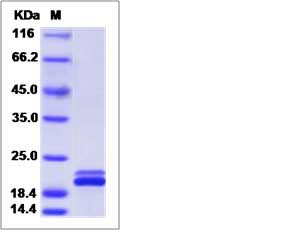Rat IFNA5 / IFNaG Protein (His Tag)
IFNA5
- 100ug (NPP3112) Please inquiry
| Catalog Number | P80205-R08Y |
|---|---|
| Organism Species | Rat |
| Host | Yeast |
| Synonyms | IFNA5 |
| Molecular Weight | The recombinant rat IFNA5 consists of 178 amino acids and predicts a molecular mass of 20.8 kDa. |
| predicted N | Leu 22 |
| SDS-PAGE |  |
| Purity | > 95 % as determined by SDS-PAGE. |
| Protein Construction | A DNA sequence encoding the rat IFNA5 (XP_001076062.1) (Leu22-Glu189) was expressed with a polyhistidine tag at the C-terminus. |
| Bio-activity | |
| Research Area | Cell Biology |Apoptosis |Caspase & inhibitor |Caspase inhibitors |
| Formulation | Lyophilized from sterile PBS, pH 7.4. 1. Normally 5 % - 8 % trehalose and mannitol are added as protectants before lyophilization. Specific concentrations are included in the hardcopy of COA. |
| Background | Interferon, alpha 5 (IFNA5) belongs to the alpha/beta interferon family. IFNA5 is the only IFNA subtype detected in normal liver, while a mixture of subtypes is observed in the liver tissue of patients with chronic hepatitis C. Interferons are produced by macrophages, IFN-alpha have antiviral activities. Interferon stimulates the production of two enzymes: a protein kinase and an oligoadenylate synthetase. IFN-alpha, the first cytokine to be produced by recombinant DNA technology, has emerged as an important regulator of growth and differentiation, affecting cellular communication and signal transduction pathways as well as immunological control. Originally discovered as an antiviral substance, the efficacy of IFN-alpha in malignant, viral, immunological, angiogenic, inflammatory, and fibrotic diseases suggests a spectrum of interrelated pathophysiologies. IFN-alpha emerged as a prototypic tumor suppressor protein that represses the clinical tumorigenic phenotype in some malignancies capable of differentiation. |
| Reference |
